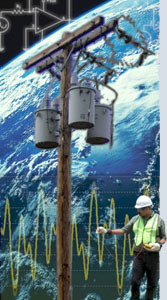Swimming Pool Handrail and Deck Shocking: Case 2
Shelby, North Carolina, USA
Background
The owner of a home was concerned about a shocking sensation that she and her family felt as they used the handrail to get out of their swimming pool. The pool had a flagstone deck. Also, the owner was getting shocked in a fish pond next to the swimming pool, at her irrigation water pump, and at her metal water faucet. The flagstone deck was common to both the fish pond and the swimming pool.
The initial investigation considered several possibilities:
- Faulty wiring on the owner's side.
- Open or damaged system neutral.
Action Taken
The possible causes were ruled out by:
- Temporarily de-energizing the owner's wiring by pulling the power meter
- Inspecting the system neutral because the area where the owner's home was located is subject to tree-related damage.
The next step in the investigation was to measure the shocking voltage and to check for proper bonding at the swimming pool. The shocking voltage was measured at 7 VAC from the pool's water to the handrail. The swimming pool's flag-stone deck and handrail were not bonded. The owner was informed of the lack of bonding for the flagstone and handrail.
The next step was to take current readings and neutral-to-earth voltage (NEV) measurements on the circuit. The decreasing NEV values indicate that the shocking voltage was related to the load on the single-phase line.
The primary current reading on the single-phase line was 60 amps at the owner's tap. The line recloser was overloaded, and the owner was seeing 111.5 volts at the meter. The results are shown in Table 1. The current readings and the NEV measurements indicate that the shocking voltage was a function of load on the long single-phase line.
 |
| Table 1: Measurements Taken at the Owner's Tap |
Solutions
The solution to the owner's shocking voltage was to bond the flagstone deck and the pool's handrail. Also, the load on Section #1 of the single-phase line should be transferred to adjacent taps to reduce the load and to balance the three-phase load at the owner's tap. This single-phase load reduction would improve the owner's voltage.

